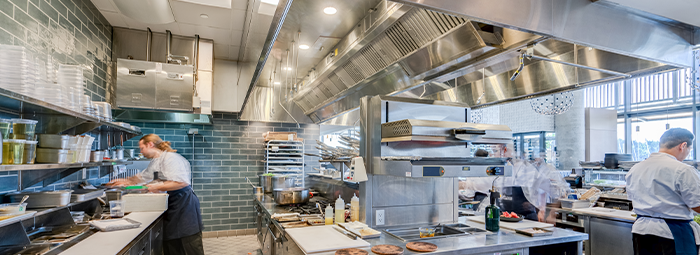
©2022 This excerpt taken from the article of the same name which appeared in ASHRAE Journal, vol. 64, no. 9, September 2022.
About the Authors
Marije te Kulve is a lighting and indoor climate specialist, and Atze Boerstra, Ph.D., is managing director at bba binnenmilieu in The Hague, The Netherlands. Marcel Loomans, Ph.D., is faculty of the Built Environment, University of Technology, Building Performance IEQ-Health, in Eindhoven, The Netherlands. Derek Schrock is North America R&D director, Foodservice SBA, Halton Company, Scottsville, Ky.
ASHRAE's Kitchen Ventilation technical committee, TC 5.10, has researched many aspects of commercial kitchens, including what factors impact the hood performance, which is the ability of an exhaust hood to remove all the grease, smoke, heat, moisture and other cooking effluents from a kitchen space. Three research projects1 – 3 characterized the grease emissions present in the exhaust for a large variety of appliances. Another4 investigated thermal comfort in commercial kitchens. However, none evaluated the impact of those grease emissions with regard to what levels of particulate matter (PM) were reaching the staff or customers, the subject of this article.
It is well documented that exposure to high concentrations of PM, and especially smaller particles (<2.5 micron, PM2.5) are known to negatively affect health.5 Recently, we have become aware that people are not just exposed to elevated PM levels outdoors. Indoor activities contribute to PM2.5 exposure as well. One major PM2.5 contributor in dwellings was found to be cooking (e.g., stir-frying). Many studies now have focused on PM2.5 exposure in residential kitchens.6 However, less is known about the daily PM2.5 exposures of chefs in professional kitchens—and how these exposure levels compare with general levels that are identified as safe based on outdoor sources, e.g., by the World Health Organization (WHO), whose daily maximum level is 25 μg/m3. It should also be noted that the WELL Standard v2 (www.wellcertified.com) has an indoor PM2.5 threshold of 35 μg/m3.
The research results presented in this paper are from research conducted in Europe and focus on identifying the PM2.5 exposure levels of chefs and staff in professional kitchens. That was done in two ways:
- The sensitivity of the exposure level to the presence and functioning of an exhaust hood and ventilation was investigated in a controlled situation (a kitchen laboratory); and
- Exposure levels were measured in-situ in several normally functioning kitchens of restaurants in the Netherlands.
In both, the investigators included factors that may influence exposure levels, like the type of food that is prepared, layout and characteristics of the kitchen, exhaust hood characteristics, overall ventilation setting, etc. During the field study we wanted to explore the actual PM2.5 exposure of chefs and staff in professional kitchens in the Netherlands. Results from a research study7 conducted for professional kitchens indicate that these levels are orders of magnitude higher than what is generally regarded as safe.
Read the Full Article
ASHRAE Members have free access to the full-text PDF of this article as well as the complete ASHRAE Journal archives back to 1997 in the Free Member Access Area.
Non-members can purchase features from the ASHRAE Bookstore. Or, Join ASHRAE!
Return to Featured Article Excerpts
Return to ASHRAE Journal Featured Article Excerpts